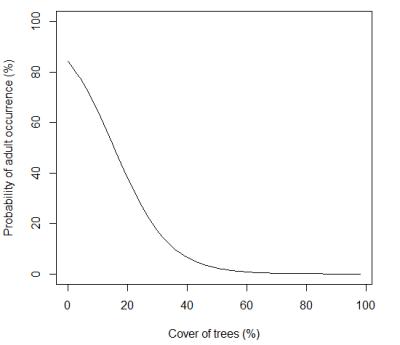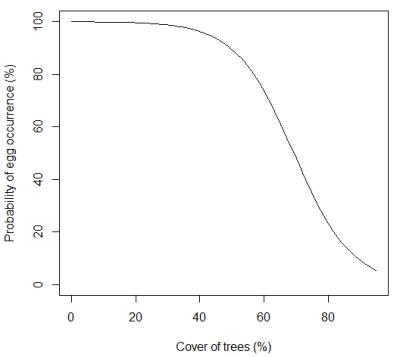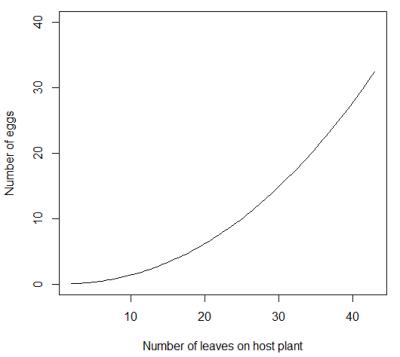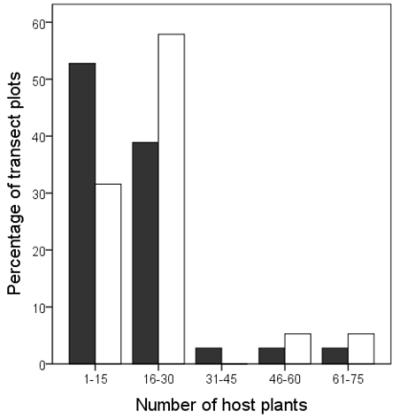Findings
Among the eight sites that were used in analysis of adult occurrence and abundance, a total of 101 S. orion adults were observed.
Among the six sites that were used in analysis of egg occurrence and abundance, a total of 921 S. orion eggs were found.
Adult and egg occurrence is affected by tree cover
The probability of adult occurrence increased with decreasing tree cover (Figure 1). The probability of finding adults was greater than 50 % when tree cover was less than 20 %. This may be because S. orion adults, like many other butterfly species, depend on sunshine for upholding flight activity. High tree cover shadows the area and decrease local temperatures, and should therefore be avoided.

The probability of egg occurrence increased with decreasing tree cover (Figure 2). The probability of finding eggs was greater than 50 % when tree cover was less than 70 %. Most egg-bearing S. maximum plants were found in areas with no tree cover. Thus, besides dwelling in open habitats, S. orion females predominately placed their eggs on S. maximum plants growing in areas with low tree cover. However, females oviposited in areas with higher tree cover (< 70 %) than that preferred by dwelling adults (< 20 %). Since S. orion inhabits rather exposed rock outcrops and slopes, moderate tree cover may protect eggs and larvae in windy weather. Shade provided by tree cover may also improve the nutritional status of host plants and thus be beneficial for larval development.

Egg abundance is affected by the number of leaves on host plants
The number of S. orion eggs on S. maximum plants increased significantly with the number of leaves on the stem (Figure 3). By placing their eggs on host plants with a large number of leaves, females may ensure that larvae have enough food for development.

Egg abundance is affected by bush cover
The number of S. orion eggs on S. maximum plants increased with increasing bush cover. However, this increase occurred over a small range of relatively low bush cover. More eggs per plant were found in areas with 0-30 % of bush cover, whereas fewer eggs per plant were found in areas with higher bush cover. Similar to tree cover, bushes may protect eggs and larvae in windy weather.
Egg abundance is affected by the proportion of bare rock and bare ground
The number of S. orion eggs on S. maximum plants increased with the proportion of bare rock or bare ground. High proportions of bare rock or bare ground increase the temperature at ground level resulting in a warm microclimate. Since S. orion is a small butterfly flying in spring and early summer, warm microclimatic conditions may be important to maintain adult activity. Warm microclimatic conditions may also fulfill the temperature requirements of early life stages and decrease the developmental times of eggs and larvae. Shortened developmental times may be vital for butterflies inhabiting the cool limits of their ranges because larvae can reach diapause before host plant senescence.
Egg abundance is affected by the number of host plants
The number of S. orion eggs on S. maximum plants decreased with increasing number of surrounding host plants. This may be because S. orion butterflies spread their eggs among S. maximum plants growing in large host plant stands. Egg spreading reduces intra-specific competition over food resources and may thus enhance larval feeding and development. At the same time, the higher egg numbers on S. maximum plants in small host plant stands may simply be due to that there are few other plants available. Too large egg numbers on host plants growing in small stands may cause over-exploitation of host plants and thus reduce larval growth and survival.
However, transect plots with a higher density of S. maximum plants had a higher frequency of S. orion eggs (Figure 4). Thus, at a plant scale the number of eggs may not necessarily be higher on plants in large host plant stands, whereas at a transect scale eggs occur where the density of host plants is higher.

Responsible for this page:
Director of undergraduate studies Biology
Last updated:
05/22/13
